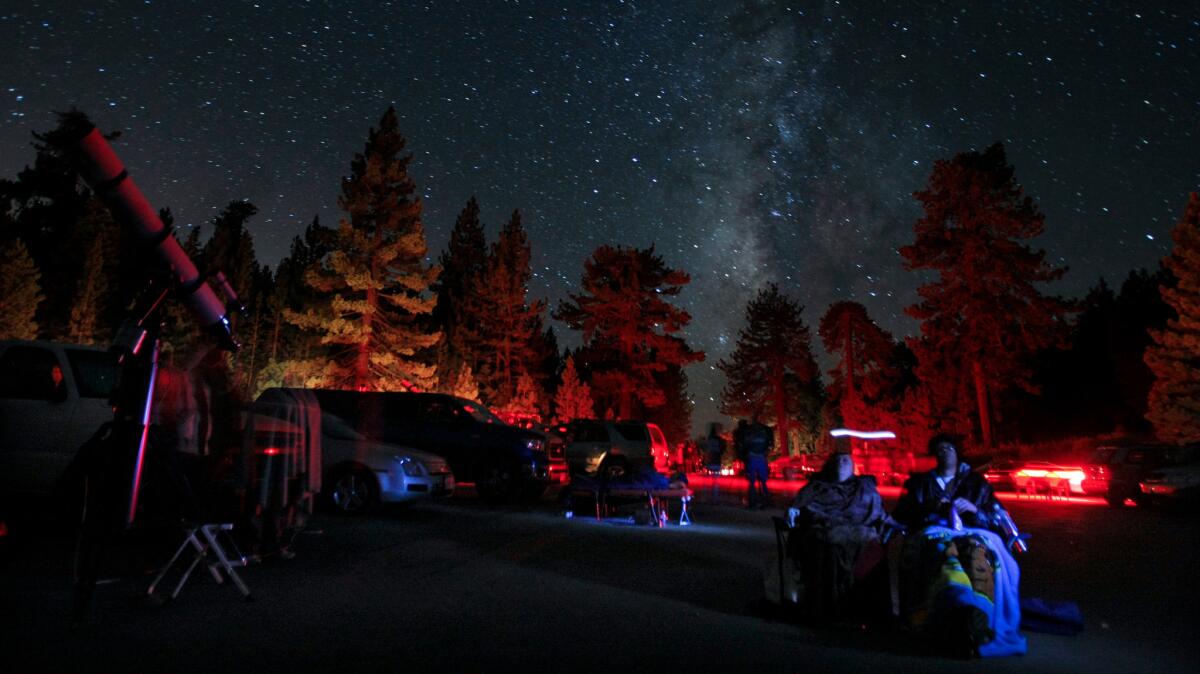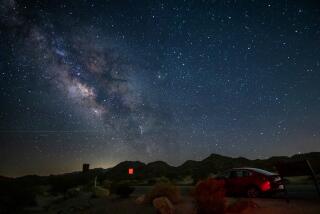Light pollution prevents 1 in 3 Earthlings from seeing the Milky Way at night

- Share via
Across the globe, light pollution is making the night sky lighter and the stars harder to see, according to a new study.
In a paper published Friday in Science Advances, researchers reveal that 1 in 3 people worldwide are unable to see the Milky Way when they gaze at the heavens in their hometown. In addition, a whopping 83% of the world’s population lives under light-polluted skies.
In Singapore – the country with the most light pollution in the world -- the skies never go dark, the authors write. Even at 1 a.m. the sky more closely resembles the warm glow of twilight then the inky blackness of a true night.

This video shows the Atlas of Artificial Sky Luminance displayed over Earth rotating in space. (Falchi et. al / Nataliya Rvbnikova)
The situation is almost the same in other countries worldwide including Kuwait, Qatar, United Arab Emirates, Saudi Arabia, South Korea, Israel and Argentina. In all of these countries, more than half of the population never experiences a truly dark night.
In the U.S. and Europe, 99% of people live under light-polluted skies, the scientists report. The Milky Way remains hidden from 80% of North Americans and 60% of Europeans.
“Humanity has enveloped our planet in a luminous fog that prevents most of the Earth’s population from having the opportunity to observe our galaxy,” wrote the research team led by Fabio Falchi of the Light Pollution Science and Technology Institute in Thiene, Italy.
For this study, the researchers gathered satellite data from NASA’s VIIRS satellite to create a World Atlas of Artificial Sky Luminance. The measurements were taken at 1 a.m. local time across the globe, because that’s when the satellite passed over each site.
See the most-read stories in Science this hour »
The authors say the light situation is almost certainly worse earlier in the evening.
There are some places in the world where people still do live under pristine skies. The scientists found that the populations of Chad, Central African Republic and Madagascar are least affected by light pollution.
They also looked at which areas of the planet are farthest from a good, clear view of the Milky Way. Residents of Egypt who live near Cairo have to travel the most distance to get to a sky dark enough to give them even a possibility of seeing the Milky Way. Runners-up include Belgium, the Netherlands, parts of Germany, northern Italy, and a series of cities in the northeast United States from Boston to Washington.
The authors note that there are well-known and effective techniques to mitigate light pollution. For example, shielding outdoor lights so they only send light down, not up. Also, using just enough light for a task and not more, and turning lights off when they are not needed. New technologies like street lights that use real-time sensors to get brighter when cars approach would also help.
At the end of the paper, the researchers conclude that humanity’s relationship with the night sky is at a crossroads.
It is possible that we will take more control of the light we generate and the current generation will be the last to have such a dim view of a cosmos masked by a haze of artificial light, the researchers say. Or we won’t do anything, and the world will continue to brighten until the entire population of Earth is deprived of the wonder that comes from gazing at a sky glittering with all of its potential starry majesty.
The choice, they say, is ours.
Do you love science? I do! Follow me @DeborahNetburn and “like” Los Angeles Times Science & Health on Facebook.
MORE IN SCIENCE
How to capture carbon dioxide from the atmosphere and turn it into stone
Bioluminescence is so useful to fish that it evolved 27 times, study says
Fossils discovered in Indonesian cave might represent ancestors to mysterious “Hobbit” species
UPDATES:
6:11 p.m.: This article was updated with additional details from the study, including the researchers’ recommendations for mitigating light pollution.
This article was originally published at 1:38 p.m.







